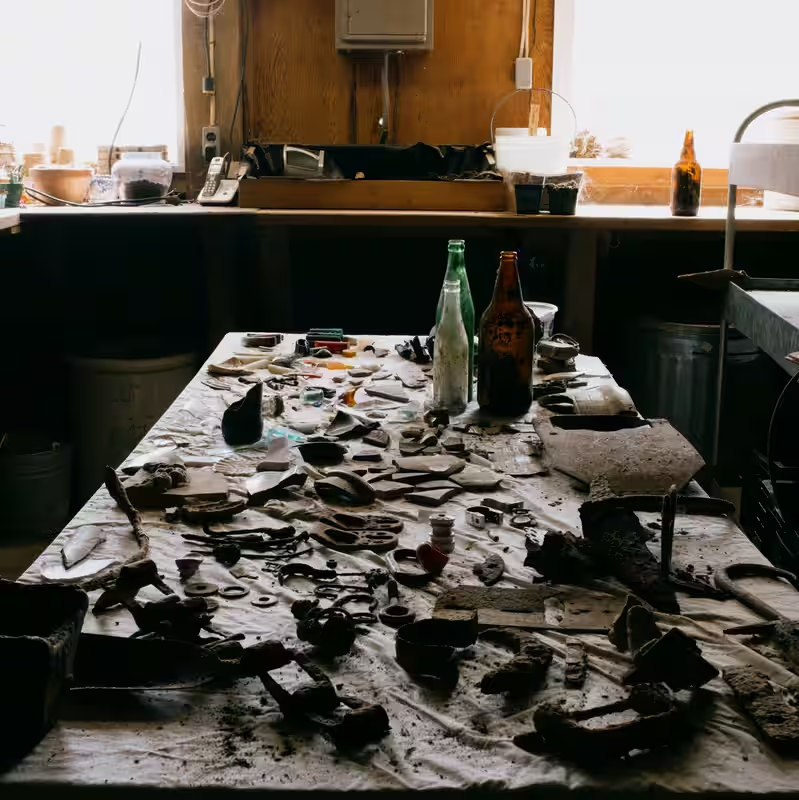
For decades, the mystery lingered like dust in the rafters: Who built the old log house nestled in the hills of western Pennsylvania? When was it really constructed? And what did daily life look like for those who first walked its creaky floorboards?
The answer didn’t come from land deeds, tax records, or even local historians. It came from trash—discarded bottles, broken pottery, rusted tools, and oyster shells scattered across the property. To most, it was litter. To archaeologists, it was a time capsule.
Artifacts as Historical Clues
After 37 years of collecting random objects found in fields and woods around their home, one Pennsylvania couple finally invited archaeologists Tom and Pat Baker to examine their stash. What followed was a masterclass in historical detective work.
“Much of what I have found was probably trash,” the homeowner admitted. “But even trash tells a story.”
And those stories are surprisingly detailed. A shard of blue transferware pottery? Likely from the 1850s–1870s. A glass medicine bottle with an embossed label? Common in post–Civil War households. Even shotgun shells and animal bones offered clues about diet, hunting practices, and economic status.
Why Artifacts Matter More Than Documents
Official records only go so far—especially in rural areas where documentation was sparse or lost to time. But everyday objects don’t lie. They reveal what people actually used, ate, and valued, not just what was written in ledgers.
In this case, the artifacts pointed strongly to a construction date around 1860—confirming the homeowner’s long-held hunch. The presence of industrial-era glass and mid-19th-century ceramics aligned with the settlement patterns of the region during the Pennsylvania frontier era.
From Litter to Legacy: A New View of “Trash”
This story flips the script on how we see discarded items. In an age of fast fashion and single-use plastics, we rarely think of our waste as historically significant. But future archaeologists might judge our era by the soda cans, phone chargers, and polyester shirts we leave behind.
The Pennsylvania find also highlights a growing field: contemporary archaeology, which studies recent human activity through material culture—even if that culture includes plastic wrappers and energy drink cans.
| Artifact Type | Estimated Era | What It Reveals |
|---|---|---|
| Blue transferware pottery | 1850s–1870s | Middle-class household, access to mass-produced goods |
| Hand-blown glass bottles | Pre-1880s | Local or regional production, limited industrialization |
| Oyster shells | Late 1800s | Surprising luxury—oysters were once cheap and widely eaten inland |
| Rusted farm tools | 1860s–1900 | Subsistence farming, self-reliant lifestyle |
A Personal Connection to the Past
For the current homeowners, the discovery wasn’t just academic—it was emotional. “I’m grateful they built this house,” the writer reflected, referring to the unknown 19th-century settlers. “They endured harsh winters, isolation, and uncertainty so we could have a home rooted in history.”
Now, every creak in the floorboard carries a nameless story. Every shard in the drawer is a whisper from the past.
How You Can Start Your Own Backyard Archaeology
You don’t need a degree to begin. Here’s how to get started:
- Walk your property slowly after rain—wet soil reveals hidden objects.
- Keep a log of where you find items (GPS or simple sketches help).
- Never dig without permission—surface collecting is legal; excavation often isn’t.
- Contact local historical societies or university archaeology departments for help identifying finds.
As the Pennsylvania case shows, history isn’t always in books. Sometimes, it’s half-buried in your backyard—waiting to be seen not as litter, but as legacy.




